

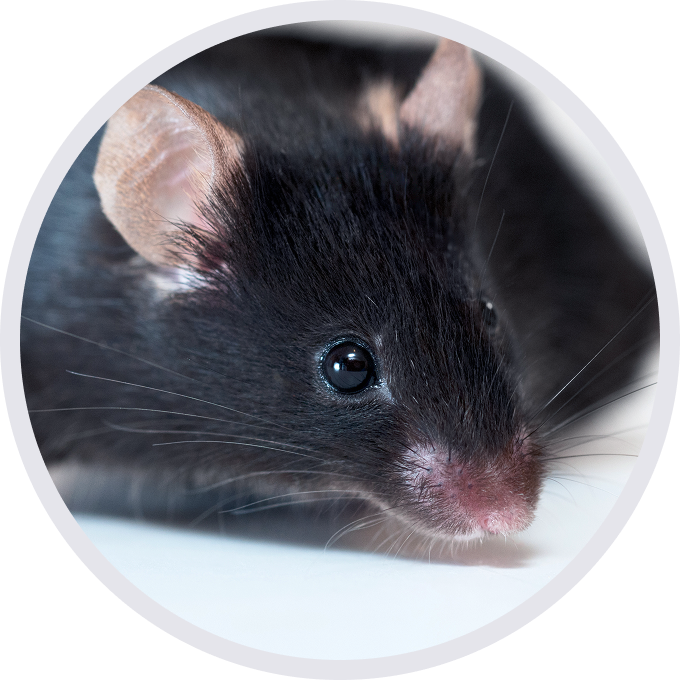
C57BL/6-Garptm1(GARP)BcgenTGFB1tm1(TGFB1)Bcgen/Bcgen • 112241
| Product name | B-hGARP/hTGFB1 mice |
|---|---|
| Catalog number | 112241 |
| Strain name | C57BL/6-Garptm1(GARP)BcgenTGFB1tm1(TGFB1)Bcgen/Bcgen |
| Strain background | C57BL/6N |
| Aliases | GARP(LRRC32,CPPRDD,D11S833E);TGFB1(CED,LAP,DPD1,TGFB,IBDIMDE,TGFbeta,TGF-beta1) |
Gene targeting strategy for B-hGARP/TGFB1 mice. The exons 1-2 of mouse Lrrc32 gene that encode the full-length were replaced by human LRRC32 exon 1-2 in B-hGARP/TGFB1 mice. The human TGFB1 gene that encode the full-length protein was inserted following part of the exon 2 of the mouse Tgfb1 gene in the B-hGARP/hTGFB1 mice.
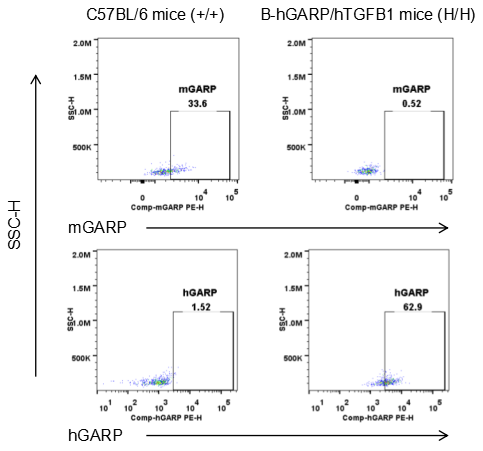
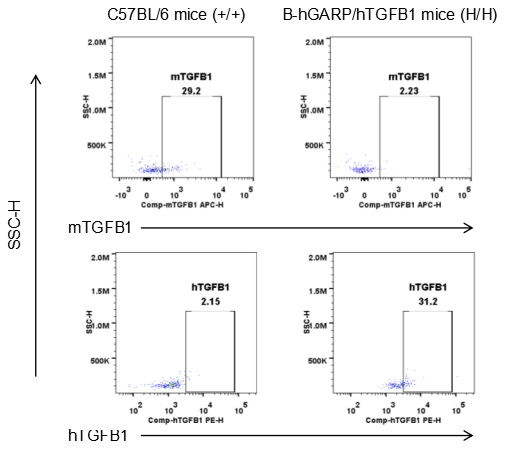
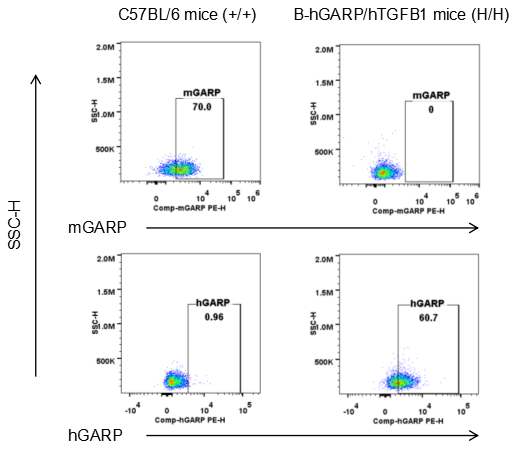
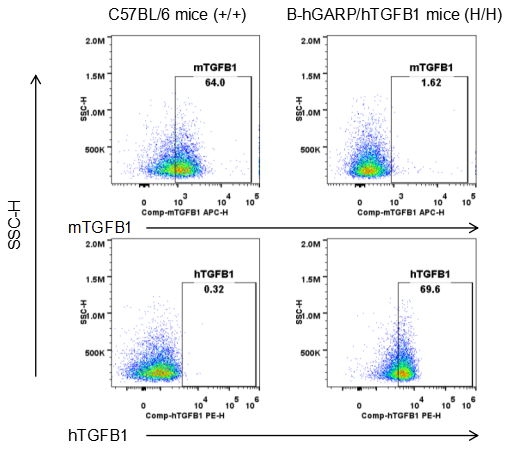

Analysis of spleen leukocyte subpopulations by FACS. Splenocytes were collected from WT and homozygous B-hGARP/hTGFB1 mice (n=3, 6-week-old). Flow cytometry analysis of the splenocytes was performed to assess leukocyte subpopulations. A. Representative FACS plots. Single live cells were gated for the CD45+ population and used for further analysis as indicated. B. Results of FACS analysis. The percentages of T cells, B cells, NK cells, dendritic cells, granulocytes, monocytes, and macrophages in homozygous B-hGARP/hTGFB1 mice were similar to those in the C57BL/6 mice, demonstrating that introduction of hGARP/hTGFB1 in place of its murine counterpart does not change the overall development, differentiation or distribution of these cell types in the spleen. Values are expressed as mean ± SEM.
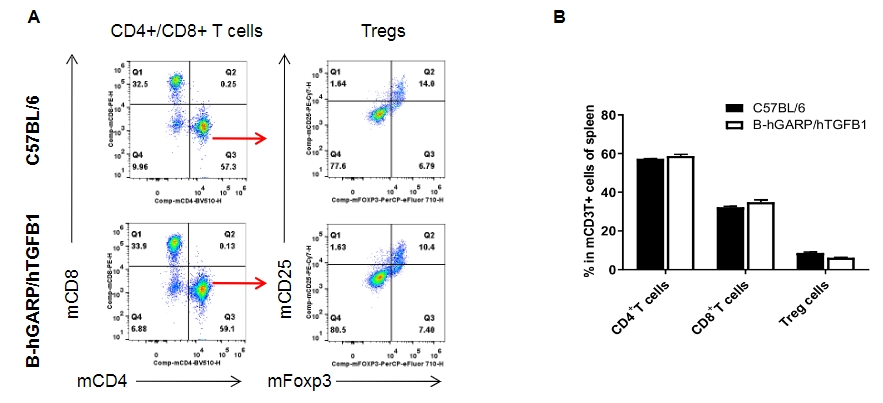
Analysis of spleen T cell subpopulations by FACS. Splenocytes were isolated from female C57BL/6 and homozygous B-hGARP/hTGFB1 mice (n=3, 6-week-old). Flow cytometry analysis of the splenocytes was performed to assess leukocyte subpopulations. A. Representative FACS plots. Single live CD45+ cells were gated for CD3+ T cell population and used for further analysis as indicated. B. Results of FACS analysis. The percentages of CD8+ T cells, CD4+ T cells, and Tregs in homozygous B-hGARP/hTGFB1 mice were similar to those in the C57BL/6 mice, demonstrating that introduction of hGARP/hTGFB1 in place of its murine counterpart does not change the overall development, differentiation or distribution of these T cell subtypes in the spleen. Values are expressed as mean ± SEM.
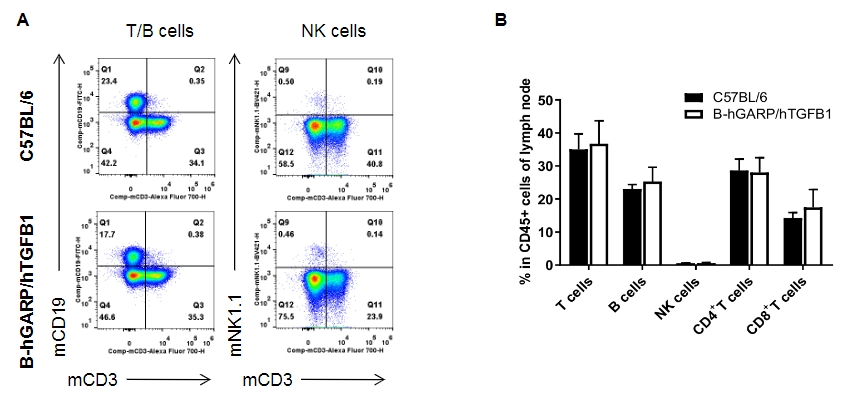
Analysis of lymph node leukocyte subpopulations by FACS. Leukocytes were collected from WT and homozygous B-hGARP/hTGFB1 mice (n=3, 6-week-old). Flow cytometry analysis of the splenocytes was performed to assess leukocyte subpopulations. A. Representative FACS plots. Single live cells were gated for the CD45+ population and used for further analysis as indicated. B. Results of FACS analysis. The percentages of T cells, B cells and NK cells in homozygous B-hGARP/hTGFB1 mice were similar to those in the C57BL/6 mice, demonstrating that introduction of hGARP/hTGFB1 in place of its murine counterpart does not change the overall development, differentiation or distribution of these cell types in the lymph node. Values are expressed as mean ± SEM.
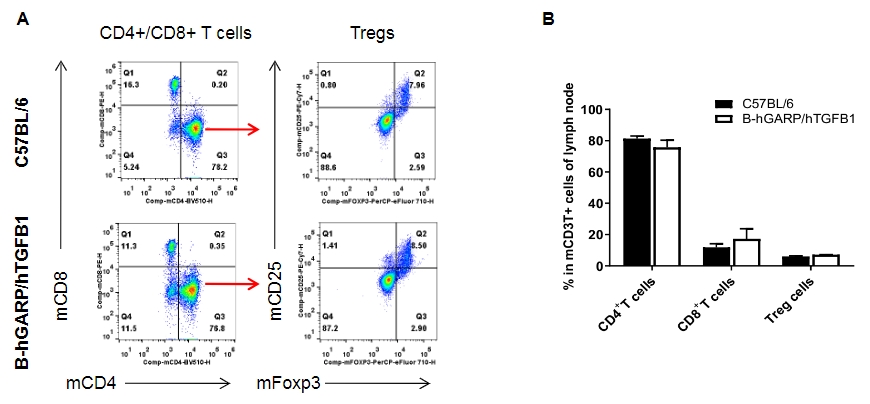
Analysis of lymph node T cell subpopulations by FACS. Leukocytes were isolated from female C57BL/6 and homozygous B-hGARP/hTGFB1 mice (n=3, 6-week-old). Flow cytometry analysis of the splenocytes was performed to assess leukocyte subpopulations. A. Representative FACS plots. Single live CD45+ cells were gated for CD3+ T cell population and used for further analysis as indicated. B. Results of FACS analysis. The percentages of CD8+ T cells, CD4+ T cells, and Tregs in homozygous B-hGARP/hTGFB1 mice were similar to those in the C57BL/6 mice, demonstrating that introduction of hGARP/hTGFB1 in place of its murine counterpart does not change the overall development, differentiation or distribution of these T cell subtypes in the lymph node. Values are expressed as mean ± SEM.

Analysis of blood leukocyte subpopulations by FACS. Blood were collected from WT and homozygous B-hGARP/hTGFB1 mice (n=3, 6-week-old). Flow cytometry analysis of the splenocytes was performed to assess leukocyte subpopulations. A. Representative FACS plots. Single live cells were gated for the CD45+ population and used for further analysis as indicated. B. Results of FACS analysis. Percent of T cells, B cells, NK cells, dendritic cells, granulocytes, monocytes, and macrophages in homozygous B-hGARP/hTGFB1 mice were similar to those in the C57BL/6 mice, demonstrating that introduction of hGARP/hTGFB1 in place of its murine counterpart does not change the overall development, differentiation or distribution of these cell types in the blood. Values are expressed as mean ± SEM
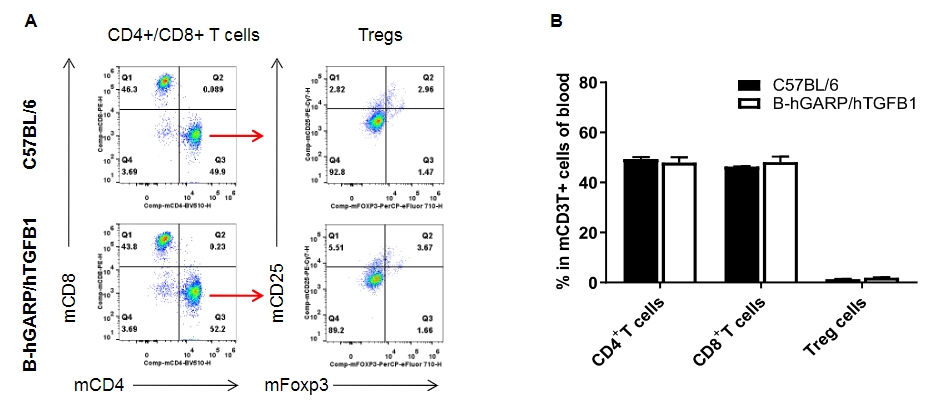
Analysis of blood T cell subpopulations by FACS. Blood were isolated from female C57BL/6 and homozygous B-hGARP/hTGFB1 mice (n=3, 6-week-old). Flow cytometry analysis of the splenocytes was performed to assess leukocyte subpopulations. A. Representative FACS plots. Single live CD45+ cells were gated for CD3+ T cell population and used for further analysis as indicated. B. Results of FACS analysis. The percentages of CD8+ T cells, CD4+ T cells, and Tregs in homozygous B-hGARP/hTGFB1 mice were similar to those in the C57BL/6 mice, demonstrating that introduction of hGARP/hTGFB1 in place of its murine counterpart does not change the overall development, differentiation or distribution of these T cell subtypes in the blood. Values are expressed as mean ± SEM.
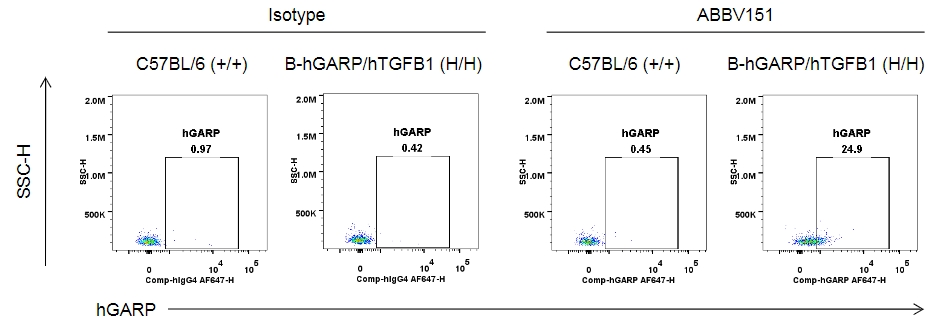
Analysis of splenocytes of B-hGARP/hTGFB1 mice by FACS. Splenocytes were isolated from homozygous B-hGARP/hTGFB1 mice. Flow cytometry analysis of the splenocytes was performed to assess anti-human GARP/latent-TGFB1 antibody ABBV151 (10 ug/mL) binding with Tregs. Tregs in homozygous B-hGARP/hTGFB1 mice bind well with ABBV151 vs isotype control.
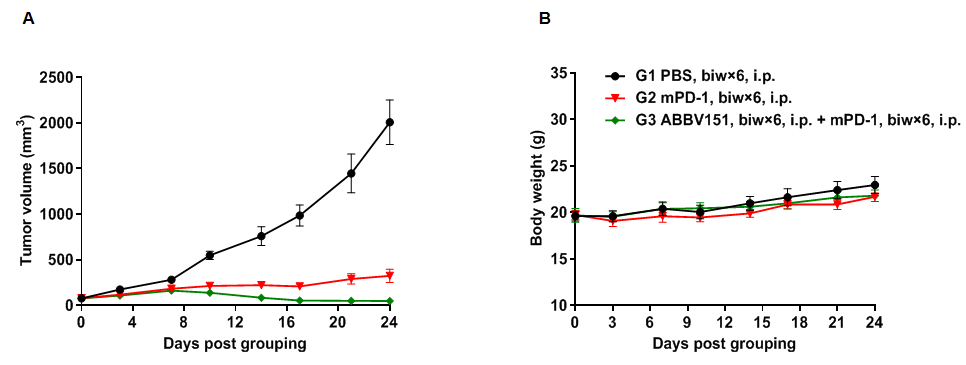
Antitumor activity of anti-mouse PD-1 antibody combined with anti-human GARP/latent-TGFβ1 antibody in B-hGARP/hTGFB1 mice. (A) Anti-mouse PD-1 antibody combined with anti-human GARP/latent-TGFβ1 antibody (in house) inhibited MC38 tumor growth in B-hGARP/hTGFB1 mice. Murine colon cancer MC38 cells (5E5) were subcutaneously implanted into homozygous B-hGARP/hTGFB1 mice (female, 7-week-old, n=6). Mice were grouped when tumor volume reached approximately 50~80 mm3, at which time they were treated with anti-mouse PD-1 antibody and anti-human GARP/latent-TGFβ1 antibody with doses and schedules indicated in panel A. (B) Body weight changes during treatment. As shown in panel A, combination of anti-mPD-1 antibody and anti-human GARP/latent-TGFβ1 antibody were efficacious in controlling tumor growth in B-hGARP/hTGFB1 mice, demonstrating that the B-hGARP/hTGFB1 mice provide a powerful preclinical model for in vivo evaluation of anti-human GARP/latent-TGFβ1 antibodies. Values are expressed as mean ± SEM.